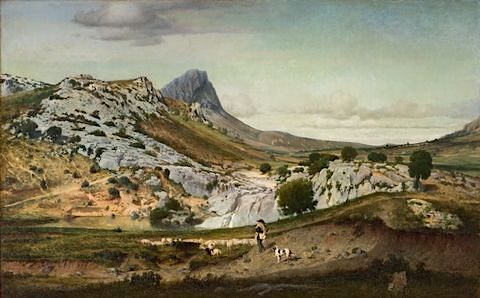GABRIEL LOPPÉ (1825-1913)
The Mont Blanc (4,808.13 m - 15,776.7 ft)
France, Italy border
In Sur le col du Géant – Soleil levant sur le Mont Blanc, oil on canvas, 51 x 35.5cm, 1890, Courtesy William Mitchell Gallery, London
The painter
Toussaint Gabriel Loppé was a French painter, photographer and
mountaineer. He became the first foreigner to be made a member of the
Alpine Club in London. His father was a captain in the French Engineers
and Loppé's childhood was spent in many different towns in south-eastern
France. Aged twenty-one Loppé climbed a small mountain in the Languedoc
and found a group of painters sketching on the summit. He had found his
calling and subsequently went off to Geneva where he met the reputed
leading Swiss landscapist, Alexandre Calame (1810 -1864).
Loppé took up mountaineering in Grindelwald in the 1850s and made
friends easily with the many English climbers in France and Switzerland.
Although he was frequently labelled as a pupil of Calame and his rival François Diday,
Loppé was almost an entirely self-taught artist. He became the first
painter to work at higher altitudes during climbing expeditions earning
the right to be considered the founder of the peintres-alpinistes
school, which became established in the Savoie at the turn of the
nineteenth century.
Notable followers of Loppé include, Charles Henri Contencin (1875-1955) and Jacques Fourcy (1906-1990).
Together with the first ascent of Mt Mallet in Chamonix’s Grandes
Jorasses range, Loppé made over 40 ascents of Mont Blanc during his
climbing career, which lasted until the late 1890s. He frequently made
oil sketches from alpine summits, including a panorama of the view from
the summit of Mont Blanc.
His paintings became celebrated for their atmosphere and spontaneity and
he soon found himself taking part in many exhibitions in London and in
Paris.
By 1896 Loppé had spent over fifty seasons climbing and painting in
Chamonix. As the valley’s unrivalled ‘Court painter’ his work was in
constant demand with the majority of his pictures going to English
climbers and summer tourists.
In his later years, Loppé became fascinated with photography and was
quite an innovator in this field too. His long exposure photograph of
the Eiffel Tower struck by lightning, now in the Musée d'Orsay in Paris
remains one of his iconic images.
The mountain
Mont Blanc (in French) or Monte Bianco (in Italian), both meaning "White Mountain",
is the highest mountain in the Alps and the highest in Europe after the
Caucasus peaks. It rises 4,808.73 m (15,777 ft) above sea level and is
ranked 11th in the world in topographic prominence. The Mont Blanc is one of the Seven Summit, which includes the
highest mountains of each of the seven continents. Summiting all of
them is regarded as a mountaineering challenge, first achieved on April
30, 1985 by Richard Bass. The 7 highest summit, (which are obviously 8
with 2 in Europe !) are :
Mount Everest (8,848m), Aconcagua (6,961m), Mt Denali or Mc Kinley (6,194m), Kilimandjaro (5,895m), Mt Elbrus (5,642m), Mount Vinson (4,892m) and Mount Kosciuszko (2,228m) in Australia.
The mountain lies in a range called the Graian Alps, between the regions
of Aosta Valley, Italy, and Savoie and Haute-Savoie, France. The
location of the summit is on the watershed line between the valleys of
Ferret and Veny in Italy and the valleys of Montjoie, and Arve in
France. The Mont Blanc massif is popular for mountaineering, hiking,
skiing, and snowboarding.
The three towns and their communes which surround Mont Blanc are
Courmayeur in Aosta Valley, Italy, and Saint-Gervais-les-Bains and
Chamonix in Haute-Savoie, France. A cable car ascends and crosses the
mountain range from Courmayeur to Chamonix, through the Col du Géant.
Constructed beginning in 1957 and completed in 1965, the 11.6 km (7¼ mi)
Mont Blanc Tunnel runs beneath the mountain between these two countries
and is one of the major trans-Alpine transport routes.
Since the French Revolution, the issue of the ownership of the summit has been debated.
_____________________________
2020 - Wandering Vertexes...
by Francis Rousseau
2020 - Wandering Vertexes...
by Francis Rousseau






